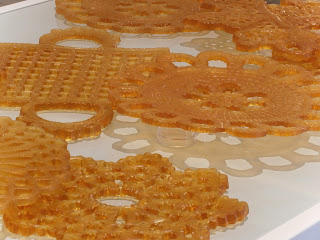the spaces between, 2011
Pears soap, acrylic and tables
Courtesy of the artist
Intersection
Soozie Coumbe, Jane Farrah,
Stephen Garrett, Niomi Sands and Gillean Shaw
6 January - 12 February
2012 | La Trobe Visual Arts Centre
About the exhibition
Intersection is
a description of the overlays that are found between one object, or material,
and another. It is the layering of both meaning and physicality with each of
these artists exploring their personal responses to this proscribed concept.
Soozie Coumbe explores the natural environment and
cultural landscape through the use of found and natural objects. Jane Farrah
re-contextualises historical and cultural objects to create a mnemonic link to
the past. Stephen Garrett explores trace, shape and structure through
transcription and measurement. Niomi Sands uses found objects as a reference
point to imply associations related to memory. Gillean Shaw uses materials
of the everyday as a referent, and as the physical material for representations
of public and personal archives.
Intersection
Museologist
Krzysztof Pomian once noted that objects in collections are prized for their
capacity to produce meaning rather than for their usefulness and concluded that
what links them all is “their ability to be involved in an exchange process
between visible and invisible worlds.”
Expanding
on this, sociologist and renowned comentator on the museum, Tony Bennett,
declared further that in public museums, objects both comprise a “domain of the
visible” but also “derive their significance from the different ‘invisibles’
they construct and from the ways in which they mediate these to the spectators,
or [as he says]...” what can be seen in such institutions is significant only
because it offers a glimpse of what cannot be seen.”
In
other words, museums construct both visible and invisible stories about life
and the universe by the way they place objects in particular sequences or
divisions - Bennett’s point was that all this points to another order of
invisible story - that of “the progress of civilisation toward the
Enlightenment”.
This
form of museum practice is one of the ways in which we construct memory, in
social, cultural and political terms. However, as everyone is well aware, it is
selective and continually open to misinterpretation or reinterpretation.
Artists, too, are concerned with the construction of the visible and the
invisible.
In
Intersection, the works all variously address issues of memory - in the
fragments we carry with us from our personal histories, to those we associate
with places and spaces we inhabit, to the collective memory of nature in the
human psyche, to the archiving of family and human concerns in the legal
system, long also a taxonomic practice of the museum.
Yet
Intersection is also about the layering of meaning that occurs between
the physicality of an object, its very materiality - its visibility - and the
meanings, the invisibility that attaches to those materials. The very nature of
the material itself conveys layers of significance embedded within it.
The
artists each have their own recollections and associations with the physicality
of their works. Each of us also bring our own associations to these materials;
many personal, some more universal. What a successful marriage of this
physicality and the layered ideas and associations brings is the possibility of
a kind of transcendance.
In
art, it’s about a power to redeem life or experience - a role usually assigned
to religion and philosophy - not always fashionable in our materialist society.
An
experience is transcendant when you are able to perceive a wholeness from all
the scattered layers - it allows a visual and conceptual dialogue with the
ideas and nature of the work. In other words, it contains the possibility of making
the invisible accessible through visible form.
Dr Angela Philp



